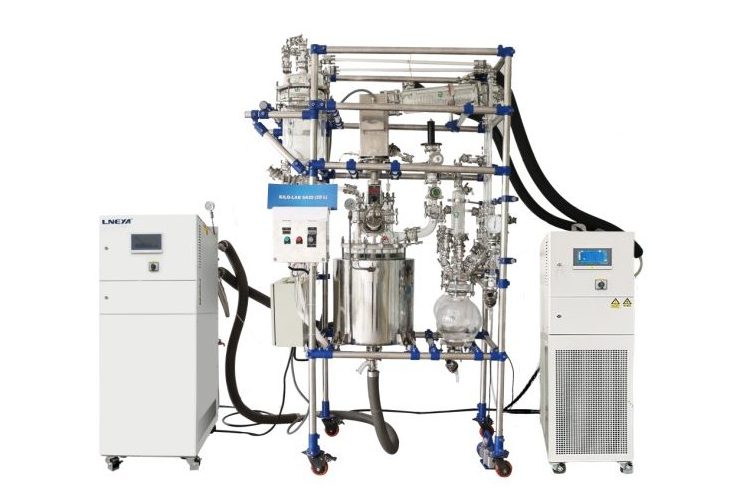Por qué utilizar refrigeradores de glicol en los sistemas de reactores de laboratorio
In labs, especially chemical, biochemical, or pharmaceutical ones, the reactor is an essential tank. It handles heating, cooling, stirring, and blending. Experiment reproducibility depends on reactor temperature. It directly affects result reliability. For effective temperature control with accuracy, an increasing number of laboratories are opting for the enfriador de glicol as a temperature control for the reactor.
Why use glycol as a coolant?
Pure water costs less than glycol, but why do most chillers employ glycol as the cooling agent? The prime reasons for this are:
Higher freezing point
The chiller will operate at 0°C, so the coolant within the pipes will freeze. Mixing glycol with water lowers the solution’s freezing point. At the right ratio, it won’t freeze even at -40°C. Therefore, glycol chillers can be operated as low as -20°C or even up to -40°C, so they’re ideal for those reactors where low temperature is required for the reaction.
Less Corrosion
Pure water acts as an electrolyte and causes electrochemical corrosion. High oxygen speeds up metal oxidation. Yet, glycol is introduced with corrosion inhibitors to create a protective coating on the surfaces of metals, preventing oxidation as well as electrochemical processes. The chiller parts made of stainless steel, copper, and aluminum are thus protected and their service life increased.
Good Stability
It will evaporate readily within high temperature conditions, particularly within open-loop applications, so it will need to be refilled often. glycol has a lower boiling point and vapor pressure. It resists deposits and acidification at high temperatures. This keeps heat transfer efficient after long use.

Advantages of glycol Chillers
Broader Temperature Range
Lab reactors handle many reaction types. Temperatures range from -40°C to +200°C. Pure water freezes at 0°C and is not capable of withstanding cold temperatures. Although thermal oil is heat-resistant, it is costly and may not be practical for small-scale laboratories. Glycol-water solution eliminates the disadvantages of the above two technologies.
It boils off gradually for high temperature handling and is slow to freeze for low temperature handling. Even when the equipment is turned off for several months, pipes will not freeze or fracture. Hence, university laboratories often employ glycol chillers for reaction temperature manipulation for low-temperature condensation as well as temperature-controlled reaction polymerization.
Reduces Temperature Fluctuations
If you’ve used an open-loop water cooling system, you likely understand the frustrations of temperature fluctuations. Glycol chillers use closed-loop systems with PID control. This allows precise heating and cooling and fast response. Temperature stays within ±1°C.
High Compatibility
Reactors come in a range of materials, some of these being stainless steel, double-glazed, glass-lined, and PTFE-coated. Coolants must be in contact with the reactor, and most reactors are costly special designs. Corrosive coolants can destroy the reactor. By adding corrosion inhibitors, glycol-water solutions within the range 30 to 50 percent show low corrosion to metals such as stainless steel and glass, making them easier to operate safely.
High Integration
Glycol chillers have an integrated design. Cooling, heating, control, and circulation are all in one unit. The advantage of not requiring a different heating system gives them a small footprint, making them perfect for small labs.

Affordable Prices
Oil chillers y water-cooled systems with cooling towers are expensive, making them unnecessary for small labs. Air-cooled glycol chillers offer a reasonable purchase price and simple maintenance, making them a cost-effective and efficient solution for reactor temperature control in small labs.
Conclusión
Are you looking for a temperature controlling system for your lab reactor? Glycol chillers have been selected by numerous labs for stable operation and high cost efficiency. LNEYA has standard models for different applications as well as customized chiller services. We apply our knowledge to assist you to overcome the most troublesome issues among different reaction processes.
Contact us now for technical support and a quote.

- What Does a 200 Ton Chiller Cost
- Temperature Control in Photolithography
- Is a Used Chiller a Good Idea
- Chiller Components and Refrigeration Fundamentals Guides
- diciembre 2025
- noviembre 2025
- octubre 2025
- septiembre 2025
- agosto 2025
- julio 2025
- junio 2025
- mayo 2025
- marzo 2025
- febrero 2025
- enero 2025
- diciembre 2024
- noviembre 2024
- octubre 2024
- septiembre 2024
- agosto 2024
- julio 2024
- junio 2024
- mayo 2024
- abril 2024
- marzo 2024
- febrero 2024
- septiembre 2023
- julio 2023
- junio 2023
- mayo 2023
- enero 2023
refrigerador por aire enfriadora Instalación de enfriadoras Chiller Maintenance chiller refrigerant refrigeradores Montaje en frío Congelador enfriador de refrigeración refrigeración calefacción cooling system sistema dinámico de control de la temperatura chiller de bajo consumo energético enfriador a prueba de explosiones congelador circulador de calefacción enfriadora industrial enfriadoras industriales refrigeración industrial congelador industrial frigorífico industrial reactor de camisa refrigerador de laboratorio refrigerador de baja temperatura noticias enfriador de aceite enfriador de proceso enfriamiento de procesos reactor enfriador refrigeración del reactor refrigeración del reactor calefacción reactor calefacción refrigeración circulador refrigerado refrigerador de tornillo enfriador de semiconductores enfriador de pruebas de semiconductores sundi tcu control de temperatura cámara de pruebas termostato refrigerador de ultra baja temperatura enfriador de pruebas de vehículos enfriador de agua refrigerador por agua
Enfriadores relacionados
CONTÁCTANOS
TEL:
EMAIL:
WeChat & WhatsApp:

Wechat QR

¿Tiene alguna pregunta o necesita un presupuesto? Complete el formulario a continuación y nuestro equipo se pondrá en contacto con usted en 24 horas.
 LNEYA Enfriadoras industriales Fabricante Proveedor
LNEYA Enfriadoras industriales Fabricante Proveedor
















